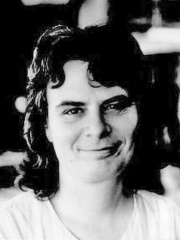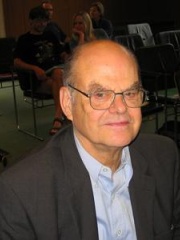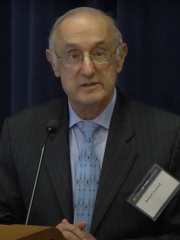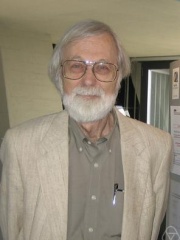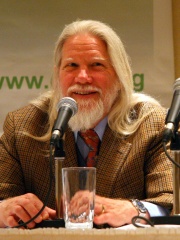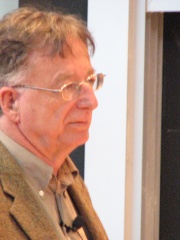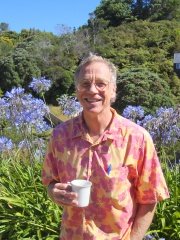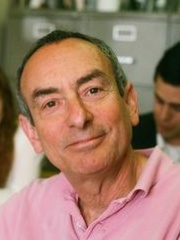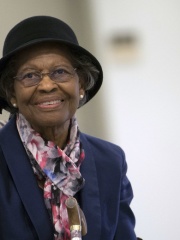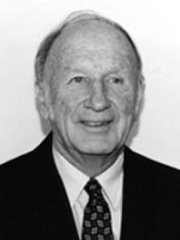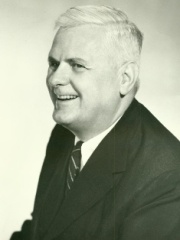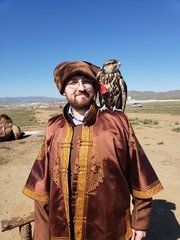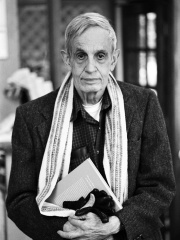
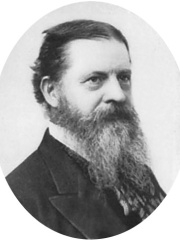
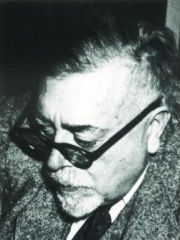

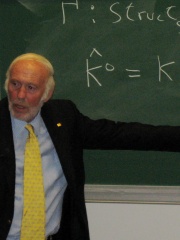
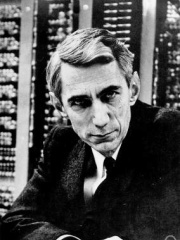
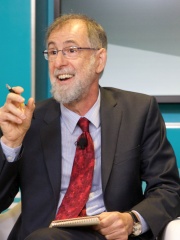
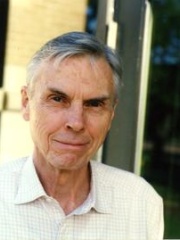
The Most Famous
MATHEMATICIANS from United States
This page contains a list of the greatest American Mathematicians. The pantheon dataset contains 1,004 Mathematicians, 105 of which were born in United States. This makes United States the birth place of the 4th most number of Mathematicians behind France, and Germany.
Top 10
The following people are considered by Pantheon to be the top 10 most legendary American Mathematicians of all time. This list of famous American Mathematicians is sorted by HPI (Historical Popularity Index), a metric that aggregates information on a biography's online popularity. Visit the rankings page to view the entire list of American Mathematicians.

1. John Forbes Nash Jr. (1928 - 2015)
With an HPI of 85.78, John Forbes Nash Jr. is the most famous American Mathematician. His biography has been translated into 95 different languages on wikipedia.
John Forbes Nash Jr. (June 13, 1928 – May 23, 2015), known and published as John Nash, was an American mathematician who made fundamental contributions to game theory, real algebraic geometry, differential geometry, and partial differential equations. Nash and fellow game theorists John Harsanyi and Reinhard Selten were awarded the 1994 Nobel Prize in Economics. In 2015, Louis Nirenberg and he were awarded the Abel Prize for their contributions to the field of partial differential equations. As a graduate student in the Princeton University Department of Mathematics, Nash introduced a number of concepts (including the Nash equilibrium and the Nash bargaining solution), which are now considered central to game theory and its applications in various sciences. In the 1950s, Nash discovered and proved the Nash embedding theorems by solving a system of nonlinear partial differential equations arising in Riemannian geometry. This work, also introducing a preliminary form of the Nash–Moser theorem, was later recognized by the American Mathematical Society with the Leroy P. Steele Prize for Seminal Contribution to Research. Ennio De Giorgi and Nash found, with separate methods, a body of results paving the way for a systematic understanding of elliptic and parabolic partial differential equations. Their De Giorgi–Nash theorem on the smoothness of solutions of such equations resolved Hilbert's nineteenth problem on regularity in the calculus of variations, which had been a well-known open problem for almost 60 years. In 1959, Nash began showing signs of mental illness and spent several years at psychiatric hospitals being treated for schizophrenia. After 1970, his condition slowly improved, allowing him to return to academic work by the mid-1980s. Nash's life was the subject of Sylvia Nasar's 1998 biographical book A Beautiful Mind, and his struggles with his illness and his recovery became the basis for a film of the same name directed by Ron Howard, in which Nash was portrayed by Russell Crowe.

2. Charles Sanders Peirce (1839 - 1914)
With an HPI of 75.56, Charles Sanders Peirce is the 2nd most famous American Mathematician. His biography has been translated into 63 different languages.
Charles Sanders Peirce ( PURSS; September 10, 1839 – April 19, 1914) was an American scientist, mathematician, logician, and philosopher who is sometimes known as "the father of pragmatism". According to philosopher Paul Weiss, Peirce was "the most original and versatile of America's philosophers and America's greatest logician". Bertrand Russell wrote "he was one of the most original minds of the later nineteenth century and certainly the greatest American thinker ever". Educated as a chemist and employed as a scientist for thirty years, Peirce meanwhile made major contributions to logic, such as theories of relations and quantification. C. I. Lewis wrote, "The contributions of C. S. Peirce to symbolic logic are more numerous and varied than those of any other writer—at least in the nineteenth century." For Peirce, logic also encompassed much of what is now called epistemology and the philosophy of science. He saw logic as the formal branch of semiotics or study of signs, of which he is a founder, which foreshadowed the debate among logical positivists and proponents of philosophy of language that dominated 20th-century Western philosophy. Peirce's study of signs also included a tripartite theory of predication. Additionally, he defined the concept of abductive reasoning, as well as rigorously formulating mathematical induction and deductive reasoning. He was one of the founders of statistics. As early as 1886, he saw that logical operations could be carried out by electrical switching circuits. The same idea was used decades later to produce digital computers. In metaphysics, Peirce was an "objective idealist" in the tradition of German philosopher Immanuel Kant as well as a scholastic realist about universals. He also held a commitment to the ideas of continuity and chance as real features of the universe, views he labeled synechism and tychism respectively. Peirce believed an epistemic fallibilism and anti-skepticism went along with these views.

3. Norbert Wiener (1894 - 1964)
With an HPI of 74.10, Norbert Wiener is the 3rd most famous American Mathematician. His biography has been translated into 63 different languages.
Norbert Wiener (November 26, 1894 – March 18, 1964) was an American computer scientist, mathematician, and philosopher. He became a professor of mathematics at the Massachusetts Institute of Technology (MIT). A child prodigy, Wiener later became an early researcher in stochastic and mathematical noise processes, contributing work relevant to electronic engineering, electronic communication, and control systems. Wiener is considered the originator of cybernetics, the science of communication as it relates to living things and machines, with implications for engineering, systems control, computer science, biology, neuroscience, philosophy, and the organization of society. His work heavily influenced computer pioneer John von Neumann, information theorist Claude Shannon, anthropologists Margaret Mead and Gregory Bateson, and others. Wiener is credited as being one of the first to theorize that all intelligent behavior was the result of feedback mechanisms, that could possibly be simulated by machines and was an important early step towards the development of modern artificial intelligence.

4. Katherine Johnson (1918 - 2020)
With an HPI of 73.76, Katherine Johnson is the 4th most famous American Mathematician. Her biography has been translated into 64 different languages.
Creola Katherine Johnson (née Coleman; August 26, 1918 – February 24, 2020) was an American human computer whose calculations of orbital mechanics as a NASA employee were critical to the success of the first and subsequent U.S. crewed spaceflights. During her 33-year career at NASA and its predecessor, the National Advisory Committee for Aeronautics, she earned a reputation for mastering complex manual calculations and helped pioneer the use of computers to perform tasks previously requiring humans. The space agency noted her "historical role as one of the first African-American women to work as a NASA scientist". Johnson's work included calculating trajectories, launch windows, and emergency return paths for Project Mercury spaceflights, including those for astronauts Alan Shepard, the first American in space, and John Glenn, the first American in orbit, and rendezvous paths for the Apollo Lunar Module and command module on flights to the Moon. Her calculations were also essential to the beginning of the Space Shuttle program, and she worked on plans for a human mission to Mars. In 2015, President Barack Obama awarded Johnson the Presidential Medal of Freedom. In 2016, she was presented with the Silver Snoopy Award by NASA astronaut Leland D. Melvin and a NASA Group Achievement Award. She was portrayed by Taraji P. Henson as a lead character in the 2016 film Hidden Figures. In 2019, Johnson was awarded the Congressional Gold Medal by the United States Congress. In 2021, she was inducted posthumously into the National Women's Hall of Fame.
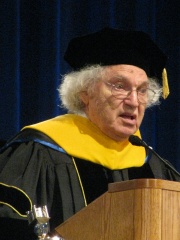
5. Herbert A. Hauptman (1917 - 2011)
With an HPI of 73.31, Herbert A. Hauptman is the 5th most famous American Mathematician. His biography has been translated into 55 different languages.
Herbert Aaron Hauptman (February 14, 1917 – October 23, 2011) was an American mathematician and Nobel laureate. He pioneered and developed a mathematical method that has changed the whole field of chemistry and opened a new era in research in determination of molecular structures of crystallized materials. Today, Hauptman's direct methods, which he continued to improve and refine, are routinely used to solve complicated structures. It was the application of this mathematical method to a wide variety of chemical structures that led the Royal Swedish Academy of Sciences to name Hauptman and Jerome Karle recipients of the 1985 Nobel Prize in Chemistry.

6. Jim Simons (1938 - 2024)
With an HPI of 72.89, Jim Simons is the 6th most famous American Mathematician. His biography has been translated into 35 different languages.
James Harris Simons (April 25, 1938 – May 10, 2024) was an American hedge fund manager, investor, mathematician, and philanthropist. At the time of his death, Simons's net worth was estimated to be $31.4 billion, making him the 55th-richest person in the world. He was the founder of Renaissance Technologies, a quantitative hedge fund based in East Setauket, New York. He and his fund are known to be quantitative investors, using mathematical models and algorithms to make investment gains from market inefficiencies. Due to the long-term aggregate investment returns of Renaissance and its Medallion Fund, Simons was called the "greatest investor on Wall Street" and more specifically "the most successful hedge fund manager of all time". Simons developed the Chern–Simons form (with Shiing-Shen Chern), and contributed to the development of string theory by providing a theoretical framework to combine geometry and topology with quantum field theory. In 1994, Simons and his wife, Marilyn, founded the Simons Foundation to support research in mathematics and fundamental sciences. The foundation is the top benefactor of Stony Brook University, Marilyn's alma mater, and is a major contributor to his alma maters, the Massachusetts Institute of Technology and the University of California, Berkeley. Simons was a member of the boards of the Stony Brook Foundation, the MIT Corporation, and the Simons Laufer Mathematical Sciences Institute in Berkeley, and chaired the boards of Math for America, the Simons Foundation, and Renaissance Technologies. In 2023, the Simons Foundation gave $500 million to Stony Brook University, the second-largest donation to a public university in U.S. history. In 2016, the International Astronomical Union named asteroid 6618 Jimsimons, which Clyde Tombaugh discovered in 1936, after Simons in honor of his contributions to mathematics and philanthropy.

7. Claude Shannon (1916 - 2001)
With an HPI of 72.12, Claude Shannon is the 7th most famous American Mathematician. His biography has been translated into 68 different languages.
Claude Elwood Shannon (April 30, 1916 – February 24, 2001) was an American mathematician, electrical engineer, computer scientist, cryptographer and inventor known as the "father of information theory" and the man who laid the foundations of the Information Age. Shannon was the first to describe the use of Boolean algebra—essential to all digital electronic circuits—and helped found the field of artificial intelligence. Roboticist Rodney Brooks declared Shannon the 20th century engineer who contributed the most to 21st century technologies, and mathematician Solomon W. Golomb described his intellectual achievement as "one of the greatest of the twentieth century". At the University of Michigan, Shannon dual-degreed, graduating with a Bachelor of Science in electrical engineering and another in mathematics, both in 1936. As a 21-year-old master's degree student in electrical engineering at MIT, his 1937 thesis, "A Symbolic Analysis of Relay and Switching Circuits", demonstrated that electrical applications of Boolean algebra could construct any logical numerical relationship, thereby establishing the theory behind digital computing and digital circuits. Called by some the most important master's thesis of all time, it is the "birth certificate of the digital revolution", and started him in a lifetime of work that led him to win a Kyoto Prize in 1985. He graduated from MIT in 1940 with a PhD in mathematics; his thesis focusing on genetics contained important results, while initially going unpublished. Shannon contributed to the field of cryptanalysis for national defense of the United States during World War II, including his fundamental work on codebreaking and secure telecommunications, writing a paper which is considered one of the foundational pieces of modern cryptography, with his work described as "a turning point, and marked the closure of classical cryptography and the beginning of modern cryptography". His work was foundational for symmetric-key cryptography, including the work of Horst Feistel, the Data Encryption Standard (DES), and the Advanced Encryption Standard (AES). As a result, Shannon has been called the "founding father of modern cryptography". His 1948 paper "A Mathematical Theory of Communication" laid the foundations for the field of information theory, referred to as a "blueprint for the digital era" by electrical engineer Robert G. Gallager and "the Magna Carta of the Information Age" by Scientific American. Golomb compared Shannon's influence on the digital age to that which "the inventor of the alphabet has had on literature". Shannon is also regarded as the most important post-1948 contributor to the theory. Advancements across multiple scientific disciplines utilized Shannon's theory—including the invention of the compact disc, the development of the Internet, the commercialization of mobile telephony, and the understanding of black holes. He formally introduced the term "bit", and was a co-inventor of both pulse-code modulation and the first wearable computer. He also invented the signal-flow graph. Shannon joined the Central Intelligence Agency's Special Cryptologic Advisory Group in 1951. From 1956 to 1978, he was a professor at MIT. He also made numerous contributions to the field of artificial intelligence, including co-organizing the 1956 Dartmouth workshop, considered to be the discipline's founding event, and papers on the programming of chess computers. His Theseus machine was the first electrical device to learn by trial and error, being one of the first examples of artificial intelligence.

8. Paul Cohen (1934 - 2007)
With an HPI of 71.36, Paul Cohen is the 8th most famous American Mathematician. His biography has been translated into 39 different languages.
Paul Joseph Cohen (April 2, 1934 – March 23, 2007) was an American mathematician, best known for his proofs that the continuum hypothesis and the axiom of choice are independent from Zermelo–Fraenkel set theory, for which he was awarded a Fields Medal.

9. John Tate (1925 - 2019)
With an HPI of 69.04, John Tate is the 9th most famous American Mathematician. His biography has been translated into 32 different languages.
John Torrence Tate Jr. (March 13, 1925 – October 16, 2019) was an American mathematician distinguished for many fundamental contributions in algebraic number theory, arithmetic geometry, and related areas in algebraic geometry. He was awarded the Abel Prize in 2010.
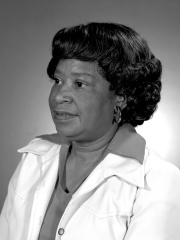
10. Mary Jackson (1921 - 2005)
With an HPI of 68.42, Mary Jackson is the 10th most famous American Mathematician. Her biography has been translated into 41 different languages.
Mary Jackson (née Winston; April 9, 1921 – February 11, 2005) was an American aerospace engineer at the National Advisory Committee for Aeronautics (NACA), which in 1958 was succeeded by the National Aeronautics and Space Administration (NASA). She worked at Langley Research Center in Hampton, Virginia, for most of her career. She started as a computer at the segregated West Area Computing division in 1951. In 1958, after taking engineering classes, she became NASA's first black female engineer. After 34 years at NASA, Jackson had earned the most senior engineering title available. She realized she could not earn further promotions without becoming a supervisor. She accepted a demotion to become a manager of both the Federal Women's Program, in the NASA Office of Equal Opportunity Programs and of the Affirmative Action Program. In this role, she worked to influence the hiring and promotion of women in NASA's science, engineering, and mathematics careers. Jackson's story features in the 2016 non-fiction book Hidden Figures: The American Dream and the Untold Story of the Black Women Who Helped Win the Space Race. She is one of the three protagonists in Hidden Figures, the film adaptation released the same year. In 2019, Jackson was posthumously awarded the Congressional Gold Medal. In 2021, the Washington, D.C. headquarters of NASA was renamed the Mary W. Jackson NASA Headquarters.
People
Pantheon has 105 people classified as American mathematicians born between 1773 and 1987. Of these 105, 40 (38.10%) of them are still alive today. The most famous living American mathematicians include Karen Uhlenbeck, John G. Thompson, and Robert Axelrod. The most famous deceased American mathematicians include John Forbes Nash Jr., Charles Sanders Peirce, and Norbert Wiener. As of April 2024, 2 new American mathematicians have been added to Pantheon including Cathy O'Neil, and Charles Hoskinson.
Living American Mathematicians
Go to all RankingsKaren Uhlenbeck
1942 - Present
HPI: 66.69
John G. Thompson
1932 - Present
HPI: 64.88
Robert Axelrod
1943 - Present
HPI: 64.65
Stephen Smale
1930 - Present
HPI: 64.46
John Milnor
1931 - Present
HPI: 62.77
Sal Khan
1976 - Present
HPI: 62.13
Whitfield Diffie
1944 - Present
HPI: 60.83
Dennis Sullivan
1941 - Present
HPI: 60.16
Michael Freedman
1951 - Present
HPI: 58.58
Ken Ribet
1948 - Present
HPI: 57.61
Gladys West
1930 - Present
HPI: 57.14
Gregory Chaitin
1947 - Present
HPI: 56.31
Deceased American Mathematicians
Go to all RankingsJohn Forbes Nash Jr.
1928 - 2015
HPI: 85.78
Charles Sanders Peirce
1839 - 1914
HPI: 75.56
Norbert Wiener
1894 - 1964
HPI: 74.10
Katherine Johnson
1918 - 2020
HPI: 73.76
Herbert A. Hauptman
1917 - 2011
HPI: 73.31
Jim Simons
1938 - 2024
HPI: 72.89
Claude Shannon
1916 - 2001
HPI: 72.12
Paul Cohen
1934 - 2007
HPI: 71.36
John Tate
1925 - 2019
HPI: 69.04
Mary Jackson
1921 - 2005
HPI: 68.42
Edward Norton Lorenz
1917 - 2008
HPI: 68.25
Alonzo Church
1903 - 1995
HPI: 68.08
Newly Added American Mathematicians (2025)
Go to all RankingsOverlapping Lives
Which Mathematicians were alive at the same time? This visualization shows the lifespans of the 25 most globally memorable Mathematicians since 1700.

